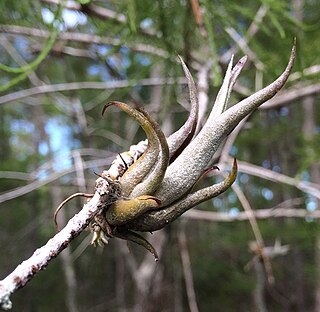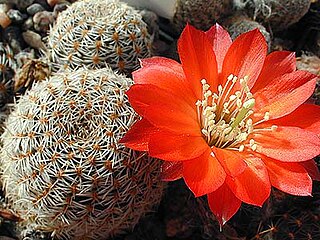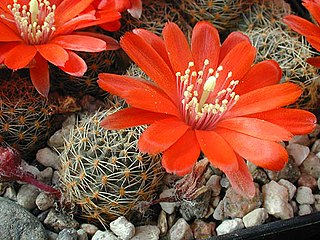
Cytisus is a genus of flowering plants in the family Fabaceae, native to open sites in Europe, western Asia and North Africa. It belongs to the subfamily Faboideae, and is one of several genera in the tribe Genisteae which are commonly called brooms. They are shrubs producing masses of brightly coloured, pea-like flowers, often highly fragrant. Members of the segregate genera Calicotome, Chamaecytisus, and Lembotropis are sometimes included in Cytisus.

Rebutia is a genus of flowering plants in the family Cactaceae, native to Bolivia and Argentina. They are generally small, colorful cacti, globular in form, which freely produce flowers that are relatively large in relation to the body. They have no distinctive ribs, but do have regularly arranged small tubercles. They are considered fairly easy to grow and they may produce large quantities of seeds that germinate freely around the parent plant.

Giovanni Papini was an Italian journalist, essayist, novelist, short story writer, poet, literary critic, and philosopher. A controversial literary figure of the early and mid-twentieth century, he was the earliest and most enthusiastic representative and promoter of Italian pragmatism. Papini was admired for his writing style and engaged in heated polemics. Involved with avant-garde movements such as futurism and post-decadentism, he moved from one political and philosophical position to another, always dissatisfied and uneasy: he converted from anti-clericalism and atheism to Catholicism, and went from convinced interventionism – before 1915 – to an aversion to war. In the 1930s, after moving from individualism to conservatism, he finally became a fascist, while maintaining an aversion to Nazism.

Aylostera, is a genus of cactus, native to central Bolivia and north western Argentina.

Weingartia is a genus in the family Cactaceae, with species native to Bolivia and Argentina. Molecular phylogenetic evidence suggests that it may be distinct from Rebutia. It is treated as a synonym of that genus by Plants of the World Online as of September 2023, but recognized as an alternative generic name in the third edition of the CITES Cactaceae Checklist. It may also be treated as Rebutia subg. Weingartia.

Nannorrhops ritchiana, the Mazari palm, is the sole species in the genus Nannorrhops in the palm family Arecaceae.
The putative Wych Elm cultivar Ulmus glabra 'Latifolia Nigricans' was first described, as Ulmus campestris latifolia nigricans, by Pynaert in 1879. Pynaert, however, did not specify what species he meant by U. campestris. The tree was supplied by the Späth nursery of Berlin in the late 19th century and early 20th as Ulmus montana latifolia nigricans. Späth, like many of his contemporaries, used U. montana both for Wych Elm cultivars and for those of the U. × hollandica group.

The tree martin is a member of the swallow family of passerine birds. It breeds in Australia, mostly south of latitude 20°S and on Timor island. It is migratory, wintering through most of Australia, New Guinea, Indonesia east of the Wallace Line and the Solomon Islands. It is a vagrant to New Zealand, where it has bred, and New Caledonia. This species is frequently placed in the genus Hirundo as Hirundo nigricans.

Tillandsia paucifolia, the potbelly airplant, is a species of bromeliad in the genus Tillandsia. This species is native to Central America, central and southern Mexico, Venezuela, Colombia, the West Indies, and Florida.

Schoenus nigricans is a species of sedge known by the common names black bog-rush and black sedge. It is native to Eurasia, parts of Africa, Australia, and southern North America, including Mexico and the southernmost United States.
A racial hoax occurs when a person falsely claims that a crime was committed by member of a specific race. The crime may be fictitious, or may be an actual crime.

Aylostera albopectinata is a species of Aylostera from Bolivia.
Sherri Papini is an American woman known for having disappeared on November 2, 2016, reportedly while out jogging a mile from her home in Redding, California. Papini was 34 years old at the time. She reappeared three weeks later on Thanksgiving Day, November 24, having been reportedly freed by her captors at 4:30 that morning still wearing restraints, on the side of County Road 17 near Interstate 5 in Yolo County, about 150 miles (240 km) south of where she disappeared.
The elm cultivar Ulmus 'Betulaefolia Nigrescens', the Black Birch-leaved Elm, reportedly a seedling of a purplish-leaved elm, was first described by Pynaert in 1879 as U. campestris betulaefolia nigrescens. An U. campestris betulaefolia nigrescensHort. was distributed by the Späth nursery, Berlin, in the 1890s and early 1900s.
Nicola Mosti is an Italian professional footballer who plays as an attacking midfielder for Serie C Group B club Virtus Entella on loan from Modena.
The Malaysian Space Agency, abbreviated MYSA, is the national space agency of Malaysia. On 20 February 2019, the Malaysian Cabinet had approved the establishment of MYSA through the merging of Malaysian Remote Sensing Agency (MRSA) and National Space Agency (ANGKASA).

Aylostera pulvinosa, synonym Rebutia pulvinosa, is a species of cactus in the genus Aylostera, native to Bolivia. Aylostera albiflora has been treated as Aylostera pulvinosa subsp. albiflora.

Aylostera pygmaea, synonyms including Rebutia pygmaea, is a species of cactus in the genus Aylostera, native to Bolivia and northwest Argentina. It has gained the Royal Horticultural Society's Award of Garden Merit.
Aylostera atrovirens is a species of flowering plant in the family Cactaceae, native to northwest Argentina and Bolivia. It was first described by Curt Backeberg in 1936 as Lobivia atrovirens.
Aylostera leucanthema is a species of flowering plant in the family Cactaceae, native to Bolivia. It was first described in 1975 as Rebutia leucanthema.











